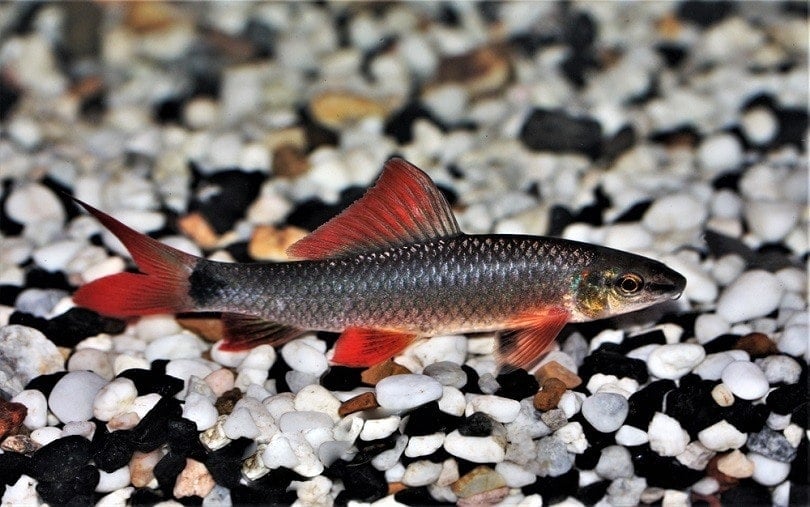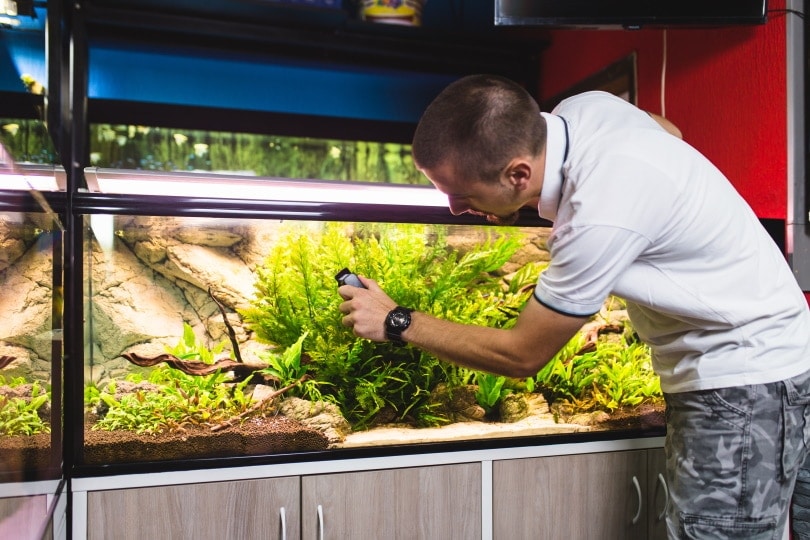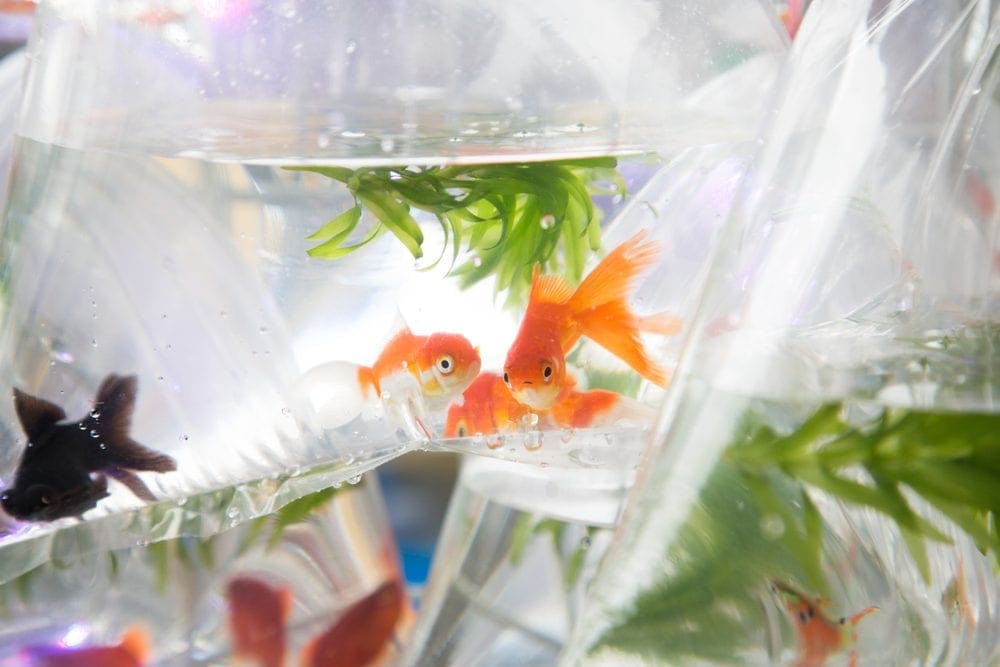Mystery Snail Eggs: Hatching Tips, Characteristics & Care Guide (Vet-Verified)
Updated on
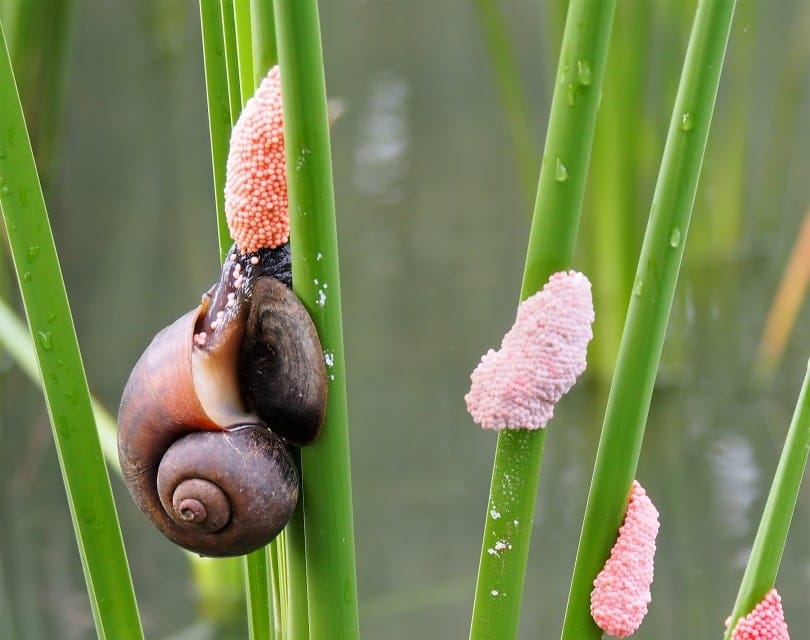
EU has banned imports of all snails in this genus.
Click to Skip Ahead
One of the largest and most popular aquarium snails is Mystery Snails, scientifically known as Pomacea. They are freshwater snails that are adored for their colorful shells, fascinating behaviors, and sociability. Mystery Snails are very easy to care for and generally reproduce prolifically in most aquariums by laying clusters of eggs.
Quick Facts about Mystery Snail Eggs
| Size: | Up to 2 inches long |
| Lifespan: | 2 – 3 years |
| Other Name: | Apple Snail |
| Similar Breeds: | Nerite Snail, Ramshorn Snail, and Apple Snails |
| Suitable for: | Beginners |
| Temperament: | Peaceful, friendly, and social |
The first thing you might notice about Mystery Snail eggs is their unusual shape and vivid red or pink coloration. Mystery Snails have some of the most unique-looking eggs of common aquarium snails. Furthermore, Mystery Snails do not lay their eggs in water, but rather above the waterline.
Their eggs are delicate and usually take 2 to 4 weeks to hatch. Once the eggs hatch, you will be dealing with hundreds of young Mystery Snails that require similar care to their adult counterparts.
Whether you have recently found a clutch of eggs, or you are looking to care for your Mystery Snail hatchlings, this article is for you.
Mystery Snail Characteristics
Mystery Snail Cost?
Mystery Snails originate from South America where they inhabit rivers, swamps, and lakes throughout Paraguay and Brazil. They are widely available around the world as pets, where they make fascinating additions to various freshwater aquariums. Mystery Snails are not difficult to find in the aquarium trade industry, nor are they expensive. They are often sold in pet stores at a cheap price, usually between $1 to $5 per snail.
Some Mystery Snail breeders breed colorful varieties of Mystery Snails that are not often found in pet stores. They include the blue and magenta varieties, which may cost a few dollars more than the chestnut or golden varieties.
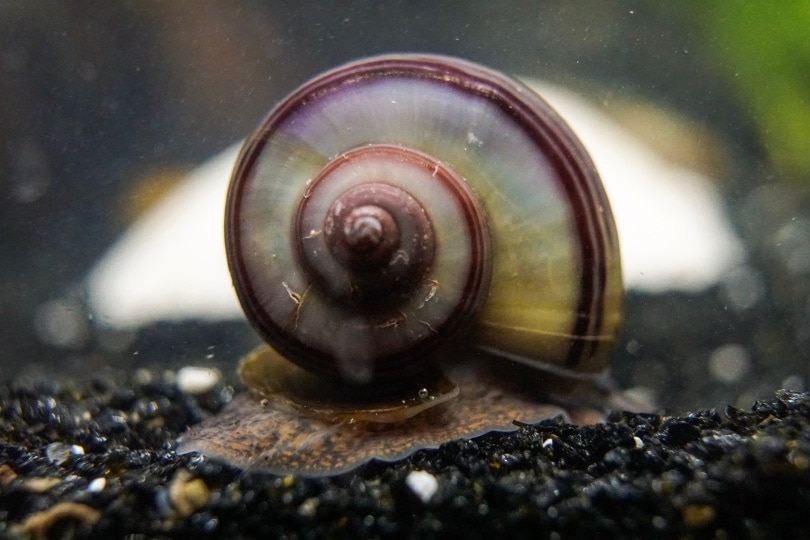
Sociability of the Mystery Snail
Do These Snails Make Good Pets?
Yes, Mystery Snails make excellent pet snails for many aquarists who can meet their care requirements. Their ease of care makes them suitable for both beginner and experienced aquarists, even if it is their first time owning snails. They are quite easy to breed and typically do it without much help from you.
Although Mystery Snails are low-maintenance pets, they still require good aquarium conditions to thrive and breed. Breeding is usually an indication that your Mystery Snails are happy in their environment as they often refuse to reproduce in poor water quality. They require a spacious tank with a filter and heater, along with good water quality and compatible tank mates.
Keep in mind that Mystery Snails can live for up to 3 years.
Does This Snail Make a Good Tank Mate?
Mystery Snails are by far one of the best non-fish tank mates for freshwater aquariums. These snails are hardy and adaptable while being incredibly peaceful. They generally keep to themselves in aquariums and get along with other fish or invertebrates that won’t injure or disturb them. If you plan to breed Mystery Snails and allow them to lay eggs, be wary that most fish will try to eat them.
You can keep Mystery Snails with other peaceful freshwater fish like tetras, and livebearers (guppies, mollies, platies). Take into consideration the tank size and water parameters when choosing suitable tank mates for your Mystery Snail. If your Mystery Snails’ eggs are touching the waterline, it is best to move them into a separate tank or container. Even the smallest aquarium fish won’t have much trouble gobbling up the delicate eggs if they fall into the water.

Care Guide & Tank Set Up
Here’s what you need to know about caring for Mystery Snails and their eggs.
Water Quality, pH & Temperature
Mystery Snails rely on having good water quality to breed, grow, and keep healthy. They need to be kept in freshwater tanks above 5 gallons in size, with a filter, and a heater. Most Mystery Snails are fine at room temperature but do best in tropical conditions. A temperature range between 60.8° to 86° Fahrenheit (16° to 30° Celsius) is acceptable. The water pH range should be alkaline at around 7.0 to 9.0.
Mystery Snail eggs do not have any specific water quality requirements since they are laid above the water. However, this also mandates leaving about an inch or two of space above your water surface, which, in turn, will limit the water volume in your aquarium.
You should never let the eggs stay fully immersed in water, as they will not hatch. The eggs stay moist and warm from humidity between the waterline and aquarium hood. If you move the eggs to a separate container, you need to place them on a moist paper towel. The container should be lidless and float in the aquarium water to maintain a suitable temperature. This method will help protect the eggs from being eaten by any tank mates and prevent them from becoming submerged in water.
Substrate
Substrate is not overly important for Mystery Snails, although certain types are better than others. Most gravel or sandy substrates are safe for Mystery Snails and can be used to create a natural environment for them or as a growth medium for live plants. Avoid sharp substrates that could injure their delicate bodies. The substrate should be rinsed before being placed into their aquarium and be free from toxins and harmful dyes that could leach into the water column.
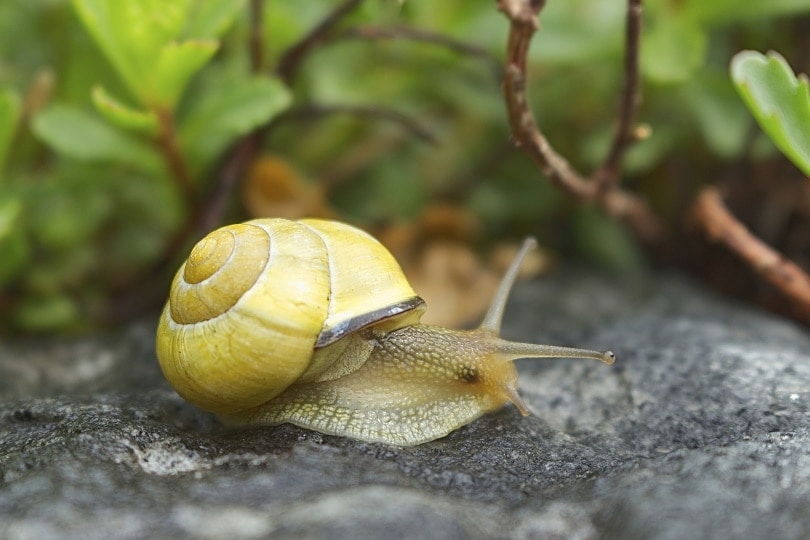
Plants
Mystery Snails can benefit from having live plants in their aquarium as both hatchlings and adults. Live plants give hatchling Mystery Snails areas to explore and hide while helping to naturally filter the water. Once your Mystery Snail eggs hatch, you will notice them gravitate toward the live plants where they will spend most of their time hiding. Live plants like hornwort, java moss, and jungle vals are recommended for Mystery Snails.
Furthermore, plants allow hatchling Mystery Snails to hide from tank mates that could eat them.
Lighting
Mystery Snails require aquarium lighting during the day and darkness at night. Most aquarists leave the lights on for 6 to 10 hours per day. Mystery Snails are sensitive to light because they are nocturnal. They are most active during the evenings and at night when the aquarium lights have been turned off. Female Mystery Snails will lay their eggs at night when they feel safest, so don’t be disappointed if you rarely see them lay their eggs during the day. Mystery Snails’ eggs can receive the same amount of lighting and darkness as the adults or hatchlings.
Filtration
A filter is essential for Mystery Snails regardless of their size. The filter prevents the water from becoming stagnant while keeping it clean and aerated. Sponge filters are commonly recommended for hatchling Mystery Snails that are still growing. This is because sponge filters are inexpensive and produce bubbles that do not create much of a current in the water. Plus, the holes in a sponge filter are far too small for hatchling Mystery Snails to get sucked into.
Hatchlings have delicate shells that are still hardening, and they can easily get sucked into a filter intake. When the hatchlings are over 1 inch in size, most filters will be safe for them.
Things to Know When Owning a Mystery Snail
Food & Diet Requirements
Mystery Snails are omnivores, regardless of their age or size. They rely on a healthy and balanced diet for proper growth and shell development. Hatchlings should be offered food as soon as they hatch.
They will eat a diet similar to the adults which consists of leafy green vegetables, sinking pellets or wafers, and live foods like bloodworms. The hatchlings will spend most of their time eating and should be offered food up to three times a day. Adult Mystery Snails can eat less frequently, usually once or twice a day.
One of the most important dietary requirements for Mystery Snails is calcium which they get from their food and aquarium water. Calcium is needed for their shell development and strength. You can offer them calcium in the form of boiled cuttlefish bone for parrots, ground chicken eggshells, or calcium rocks.

Size & Growth Rate
Mystery Snail eggs can take up to a month to hatch before hundreds of baby snails will emerge. The newly hatched Mystery Snails will be tiny and semi-transparent. It can take a few days for their shell to harden up and their growth to accelerate. Mystery Snails do most of their growth within the first 2 months of their life but maintain a steady growth rate up until a year old. Fully grown Mystery Snails can reach 2 inches in length, but some may grow larger.
Their growth rate is influenced by their water quality, diet, and tank size. Mystery Snails who are kept in cycled aquariums with well-maintained water and fed a healthy diet are going to grow faster than those in poor conditions.
Varieties
Mystery Snails can be found in an assortment of colors, most of which are unusual for aquarium snails. The most common colors seen in Mystery Snails are chestnut and gold. The rarer varieties include magenta, blue, and purple Mystery Snails. Their shell color is usually distinguishable a few days after they hatch, although the color may change slightly as they age.
- Blue
- Golden
- Jade (green)
- Dark striped olive
- Magenta
- Ivory
- Purple
- Chestnut
- Brown
Lifespan and Health Conditions
Mystery Snails have a short lifespan between 2 to 3 years. Some Mystery Snails may live shorter or longer depending on how well they are cared for. While Mystery Snails are quite healthy and hardy, they are still susceptible to certain health conditions. Most of the following health conditions are the result of poor water quality or diet.
- Slight shell abrasions
- Floating
- Receding osphradium
- Overproducing slime on their foot
- Collapsed mantle
- Bacterial infections
- Fungal infections
- Soft shells (adults)
Male vs Female
- Solid-colored shell
- Skin fold under the right antennae
- Frequent climbing or mounting behavior
- Dark patches on the whorl of their shell
- Curved shell lip
- Pointier and more elongated shell
It is a myth that Mystery Snails are hermaphrodites that can reproduce on their own. Mystery Snails are gonochoristic, so both males and females are needed for reproduction. However, female Mystery Snails can store sperm for up to 9 months from a previous successful mating period. This is why female Mystery Snails who are kept alone in an aquarium for months may suddenly lay a batch of fertilized eggs.
3 Tips on Hatching Mystery Snail Eggs
1. Do not let the eggs get submerged in water, they need to be kept moist but not fully wet.
Mystery Snail eggs need warmth and humidity to successfully hatch. The eggs cannot develop submerged in water as the eggs will suffocate. Keep the temperature of the tank warm using a heater to increase the humidity between the waterline and aquarium hood where your Mystery Snail lays eggs. If the eggs have already fallen into the water, float them on a moist paper towel or cotton wool in a container.
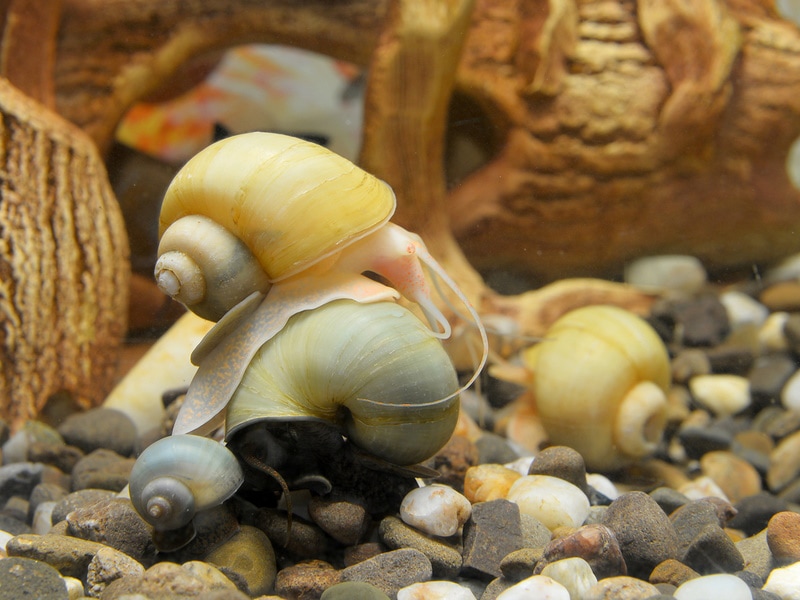
2. Wait for at least 48 hours before touching and moving the eggs because they are delicate.
The eggs will be mushy and very delicate the first 2 days they are laid, so they shouldn’t be handled yet (unless you are seasoned in breeding snails and know what you’re doing). The eggs will start a milky to pale pink coloration and darken over time. As the eggs darken, they will harden as well and become easier to handle. However, you want to avoid handling the eggs too much and rather leave them where they have been laid or keep them in a separate container until they hatch.
3. Regularly monitor the eggs to check when they are ready to hatch.
Mystery Snail eggs will turn a dark gray coloration and develop a slimy white coat when they are about to hatch. Some aquarists might mistake this slimy coating for a fungus and dispose of the eggs. However, this is a normal part of the egg’s development, and the eggs should hatch within the next few days.
Final Thoughts
Mystery Snails are popular freshwater snails that are available in different shell colors and patterns. They are known for being beginner-friendly pets and prolific breeders with unusual egg-laying habits. Mystery Snails choose to lay their eggs above the waterline in clusters that look like tiny pink grapes.
The eggs take a couple of weeks to hatch, usually no more than 4 weeks in total. The eggs can either be left where they were laid or placed in a floating container, but they should never be submerged in water. Humidity, temperature, and moisture are essential for the eggs, and they can dry out without it. Newly hatched Mystery Snails are delicate and born with soft shells that are easily damaged. They can be kept in the same tank as the adults and require similar care, feeding, and housing.
Featured Image Credit: Piqsels





